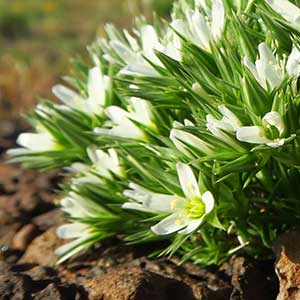Eremogone franklinii
Eremogone stenomeres
Franklin's sandwort
meadow valley sandwort
erect, 3–10(–15) cm, glabrous.
erect, 7–18 cm, glabrous.
basal leaves persistent;
cauline leaves in 6–10 pairs, closely overlapping, not reduced;
basal blades arcuate-spreading, needlelike, (0.6–)1–2 cm × ca. 1 mm, ± rigid, herbaceous, apex spinose, glabrous, not glaucous.
basal leaves persistent;
cauline leaves in 5 pairs, not reduced (stems leafy);
basal blades spreading, needlelike, 1.5–2 cm × 0.5–1 mm, rigid, not fleshy, apex spinose, glabrous, glaucous.
3–45+-flowered, usually congested, subcapitate cymes.
5–13-flowered, open cymes.
ca. 0.1–3(–4) mm, glabrous.
4–12 mm, glabrous to stipitate-glandular distally.
sepals 1–3-veined, linear-lanceolate, (5–)8.5–12 mm, not enlarging in fruit, margins narrow, apex acuminate, glabrous;
petals white, oblong-lanceolate to narrowly spatulate, 7–9 mm, 0.8–1.1 times as long as sepals, apex rounded to blunt;
nectaries not apparent.
sepals 1-veined, narrowly to broadly lanceolate, 4.5–5 mm, 6.5–7.5 mm in fruit, margins narrow, apex acuminate to spinose, glabrous to stipitate-glandular distally;
petals yellowish white, narrowly spatulate, 7.5–8.5 mm, 1.5–1.7 times as long as sepals, apex emarginate;
nectaries as lateral and abaxial rounding of base of filaments opposite sepals, 0.3–0.4 mm.
2.3–3.3 mm, glabrous.
ca. 6 mm, glabrous.
black, pyriform, 1.2–1.7 mm, tuberculate.
color not known, orbicular, ca. 1 mm, surface not known (mature seeds not observed).
Eremogone franklinii
Eremogone stenomeres
Varieties 2 (2 in the flora).
(Discussion copyrighted by Flora of North America; reprinted with permission.)
Of conservation concern.
Eremogone stenomeres is known only from a few sites in Clark and Lincoln counties. This species was recognized for its linear petals with notched apices. Rehydration of petals from representative specimens indicates that the lamina fold lengthwise upon drying, thus the linear appearance. When rehydrated, the petals were oblanceolate, with widths within the range of related taxa.
(Discussion copyrighted by Flora of North America; reprinted with permission.)
1. Inflorescences tightly congested cymes; pedicels 0.1-1(-3) mm; sepals 8.5-12 mm; petals 0.8-0.9 times as long as sepals | var. franklinii |
1. Inflorescences somewhat congested cymes; pedicels 1-4 mm; sepals 5-8 mm; petals 1-1.1 times as long as sepals | var. thompsonii |
- Local floras:
OR,
WA
- Local Web sites:
CalFlora,
CalPhotos,
Flora NW,
PNW Herbaria
WildflowerSearch
iNaturalist (observations)
- LBJ Wildflower Center
- SEINet
- Plants of the World Online
- Encyclopedia of Life
- Wikipedia
- Google Image Search


